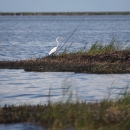
The Comprehensive Environmental Response, Compensation, and Liability Act (CERCLA, 42 U.S.C. § 9601 et seq.) and its implementing regulations authorize federal and state agencies to act as trustees of natural resources on behalf of the public. When hazardous substances are released into the environment and harm the public’s natural resources, these trustees conduct assessments to determine the extent of injury, recover monetary and other damages from the responsible parties, and use these recovered damages to plan and implement restoration actions that will compensate the public for the loss of natural resources and the services they would have provided but for the hazardous substance releases. 42 U.S.C. § 9611(i).
The federal natural resource trustee for the Duck and Otter Creeks Site (“Creeks” or “Site”) is the U.S. Department of the Interior (DOI or Department), acting through the U.S. Fish and Wildlife Service (“Service” or the “Trustee”). The Trustee prepared this Draft Restoration Plan and Environmental Assessment (Draft RP/EA) to identify and evaluate restoration projects at or in the vicinity of the Creeks that are intended to restore, replace, rehabilitate and/or acquire the equivalent of natural resources and their services injured by releases of hazardous substances from the Site. There are four settling potentially responsible parties (PRPs) who are participating in the proposed settlement with the United States, including, Ohio Refining Company, LLC, Chevron U.S.A., Inc., Pilkington North America, Inc., and Chemtrade Logistics, Inc., in Oregon, OH.
Through the CERCLA Natural Resource Damage Assessment and Restoration (NRDAR) process, the Trustee negotiated a proposed settlement with the settling PRPs to restore, replace, rehabilitate and/or acquire the equivalent of natural resources and their associated service losses injured at Duck and Otter Creeks. The Trustee determined that contamination was present in sufficient quantities to cause injury to surface water, sediment, and organisms living within, upon, or closely associated with those resources. The releases also adversely affected ecological services provided by injured resources (surface water, sediment, and related habitat).
Under the National Environmental Policy Act (NEPA; 42 U.S.C. § 4321 et seq.), federal agencies must identify and evaluate environmental impacts that may result from federal actions. This Draft RP/EA describes the purpose and need for restoration, identifies, and evaluates four potential restoration alternatives, including a No Action Alternative (Alternative One), summarizes the affected environment, and describes the potential environmental consequences of proposed restoration activities negotiated with the settling PRPs.
The restoration projects focus on restoring the types of natural resources at and in the vicinity of Duck and Otter Creeks. Public review of the restoration alternatives is an integral and important part of the restoration planning process and is consistent with applicable state and federal laws and regulations. Thus, the Trustee is soliciting comments on this Draft RP/EA and will address any public comments received in a Final RP/EA. For additional information on the terms of the proposed settlement, please see United States of America v. Ohio Refining Company, LLC, Chevron U.S.A., Inc., Pilkington North America, Inc, and Chemtrade Logistics, Inc. Four Consent Decrees (CDs), one for each settling PRP, are currently available for public review and comment on the Department of Justice website.
The proposed restoration projects include open water, river island, and wetland habitat improvement, enhancement, and preservation within the Maumee River watershed to benefit natural resources. Four Alternatives will be presented in this Draft RP/EA and will be evaluated using NRDAR and NEPA criteria.
Specifically, the four Alternatives include:
- Alternative A: No Action/Natural Recovery
- Alternative B: Delaware/Clark Island Complex Restoration Project
- Alternative C: Connected Wetland and Fish Passage at Camp Sabroske
- Alternative D: Corbutt Island Project
The Trustee will review and consider all public comments and input on the Draft RP/EA received during the public comment period prior to publishing the Final RP/EA. The Trustee will prepare a responsiveness summary to the comments that will be included as an appendix in the Final RP/EA. Based on the public’s comments, or other information, the Trustee may amend the Draft RP/EA if significant changes are made to the type, scope, or impact of the projects. In the event of a significant modification to the Draft RP/EA, the Trustee will provide the public with an opportunity to comment on that particular amendment. The public comment period will be from January 9, 2024 to February 8, 2024.
To submit a comment, request a hard copy of the Draft RP/EA, or for additional information,
Contact Amber Bellamy of the Service (contact information below).
The Natural Resource Trustee will accept written comments on the Draft RP/EA during the public comment period. Comments may be mailed or emailed to Amber Bellamy (address below). If emailing, please include “Draft RP/EA Duck and Otter Creeks NRDAR” in the subject line.
Amber Bellamy, U.S. FWS
4625 Morse Road, Suite 104,
Columbus, OH 43230



